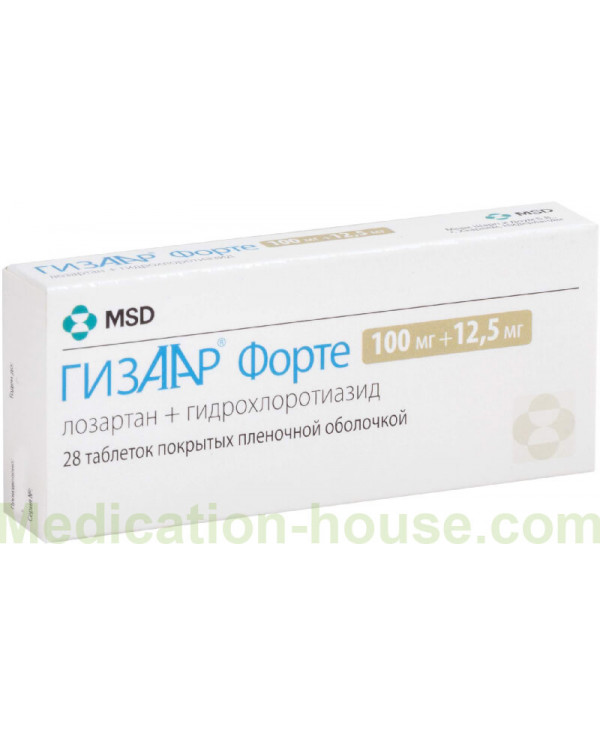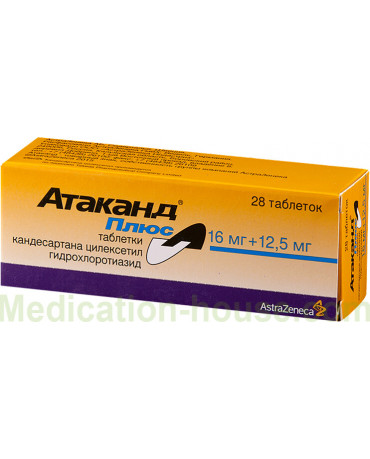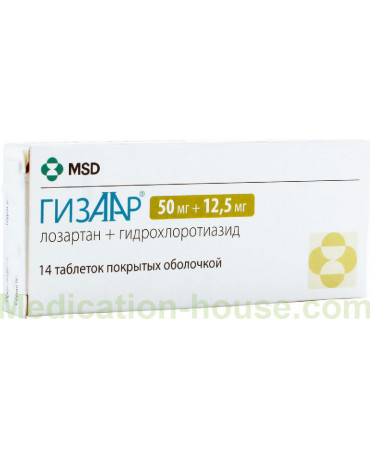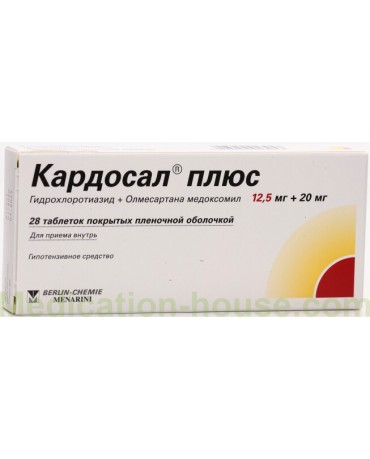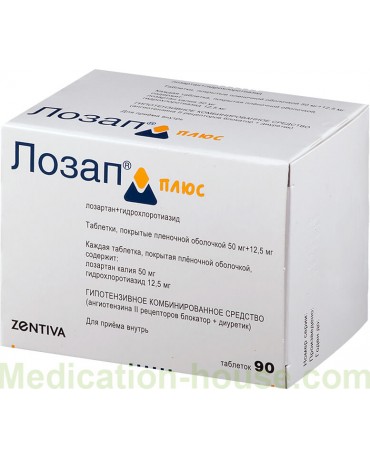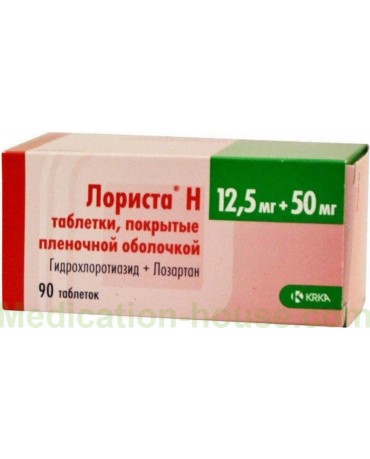Hyzaar Forte instruction
You can buy Hyzaar Forte here
Hyzaar Forte is a combined antihypertensive agent.
Release form and composition
Dosage form - film-coated tablets: oval, white, engraved on one side "745" (in a blister 10 or 14 pcs., In a cardboard box 5 blisters of 10 pcs. Or 2 blisters of 14 pcs. And instructions on the use of Hyzaar Forte).
Composition of 1 tablet:
active substances: losartan potassium - 100 mg, hydrochlorothiazide - 12.5 mg;
auxiliary components: pregelatinized corn starch, lactose monohydrate, microcrystalline cellulose (Avicel PH102), magnesium stearate;
film coating: carnauba wax, hypromellose, hyprolose, titanium dioxide (E171).
Pharmacodynamics
Hyzaar Forte is a combined drug, the active substances of which, in combination, have an additive hypotensive effect, lowering blood pressure (BP) to a greater extent than each component separately, which is due to a complementary effect.
Hydrochlorothiazide (HCT) has a diuretic effect, as a result of which the activity of blood plasma renin (ARP) increases, the secretion of aldosterone is stimulated, the concentration of angiotensin II (AT II) increases, and the level of potassium in the blood serum decreases. HCT promotes some increase in the concentration of uric acid in the blood.
Losartan blocks all physiological effects of AT II, has a moderate and transient uricosuric effect. By suppressing the effects of aldosterone, it reduces the loss of potassium caused by taking a diuretic.
When used in combination, losartan reduces the severity of hyperuricemia caused by HCT.
Hydrochlorothiazide
Hydrochlorothiazide is a thiazide diuretic with an antihypertensive effect.
The mechanism of the antihypertensive effect of thiazides is unknown. These drugs usually do not affect the normal level of blood pressure.
HCT affects the reabsorption of electrolytes in the distal renal tubules. The increase in the excretion of sodium and chlorine ions under the action of the drug is approximately the same. Natriuresis can cause a small loss of potassium and bicarbonate ions.
After oral administration of the drug, the diuretic effect develops within about 2 hours, the maximum reaches an average of 4 hours and lasts 6-12 hours.
Losartan
Angiotensin II is a powerful vasoconstrictor, the main active hormone of the renin-angiotensin-aldosterone system (RAAS), as well as a crucial pathophysiological link in the development of arterial hypertension (AH). By binding to AT1 receptors located in many tissues (including the heart, kidneys, adrenal glands, and vascular smooth muscle tissue), AT II performs several important biological functions, including aldosterone release and vasoconstriction. Also AT II promotes the proliferation of smooth muscle cells. The second type of receptors that AT II binds to is AT1 receptors, but its participation in the regulation of the function of the cardiovascular system has not been established.
Losartan is a selective angiotensin II AT1 receptor antagonist, which, when taken orally, is highly effective. Under in vitro and in vivo conditions, losartan and E-3174 (its pharmacologically active carboxylated metabolite) block all physiological effects of AT II, regardless of its source and synthesis route.
Losartan, unlike some peptide antagonists of AT II, does not possess agonist properties.
The drug binds selectively to AT1 receptors. Losartan does not bind to receptors of other hormones and ion channels, which play an important role in the function of the cardiovascular system, and also does not have a blocking effect on them.
Also, the drug does not inhibit the angiotensin-converting enzyme (ACE, kininase II), which is responsible for the destruction of bradykinin. Therefore, losartan does not have the ability to exert effects that are not directly related to the blockade of AT1 receptors, such as the development of edema and an increase in bradykinin-mediated effects.
In patients with arterial hypertension and left ventricular hypertrophy, the drug (including in combination with HCT) reduces the risk of cardiovascular morbidity and mortality. This fact was proved by assessing the combined incidence of myocardial infarction and stroke, as well as the mortality rate from cardiovascular complications in this category of patients.
Losartan suppresses the increase in systolic and diastolic blood pressure during AT II infusion. After taking a dose of 100 mg at the time of reaching the maximum plasma concentration (Cmax), the suppression of an increase in blood pressure is approximately 85%, after 24 hours (after a single and multiple doses) - 26–39%.
Against the background of losartan therapy, due to the elimination of negative feedback, manifested by suppression of renin secretion by angiotensin II, plasma renin activity (ARP) increases. This leads to an increase in the plasma concentration of AT II. With long-term use (within 6 weeks) of the drug in a daily dose of 100 mg for arterial hypertension at the time of reaching Cmax of losartan, there was a 2-3-fold increase in the plasma level of AT II, and in some patients an even greater increase, especially with a short duration of treatment ( 2 weeks). Nevertheless, in the course of therapy, the hypotensive effect and a decrease in the plasma concentration of aldosterone appeared after 2 and 6 weeks of treatment, which indicates an effective blockade of AT II receptors. After discontinuation of losartan for 3 days, ARP and AT II concentration decreased to the values that were observed before the start of its administration. The effect of Hyzaar Forte on ARP and AT II concentration is similar to that of losartan at a dose of 50 mg.
Losartan is a specific antagonist of the AT1 receptors of angiotensin II, therefore it does not suppress ACE, an enzyme that inactivates bradykinin. In a study aimed at comparing the effects of losartan at doses of 20 and 100 mg with the effects of an ACE inhibitor in terms of the effect on angiotensin I (AT I), AT II and bradykinin, it was found that losartan blocks the effects of AT I and AT II without affecting the properties bradykinin. This is due to the specific mechanism of its action. The ACE inhibitor suppressed the response to AT I and increased the severity of the effects of bradykinin, without affecting the severity of the response to AT II. This indicates a pharmacodynamic difference between losartan and ACE inhibitors. Plasma concentrations of losartan and its active metabolite, as well as the hypotensive effect, are directly dependent on the dose taken. The active metabolite of losartan is also an antagonist of angiotensin II receptors (ARA II), therefore it also contributes to the formation of the antihypertensive effect.
Studies in healthy volunteers (men) who took losartan at a dose of 100 mg once against the background of a high- and low-salt diet, did not reveal the effect of the drug on the glomerular filtration rate (GFR), filtration fraction and effective renal plasma flow. Losartan showed a natriuretic effect that was more pronounced in individuals on a low-salt diet and did not seem to be associated with inhibition of early sodium reabsorption in the proximal renal tubules. Also losartan contributed to a transient increase in the excretion of uric acid by the kidneys. In patients with hypertension and proteinuria (≥ 2 g / 24 h) without diabetes mellitus, who received the drug for 8 weeks, starting with a daily dose of 50 mg with a gradual increase to 100 mg, there was a significant decrease in proteinuria (by 42%), fractional excretion of immunoglobulins (IgG) and albumin. In these patients, the drug reduced the filtration fraction and stabilized GFR.
A 12-week parallel study followed patients with left ventricular failure (NYHA functional class II – IV), most of whom received diuretics and / or cardiac glycosides. Losartan was used in daily doses of 2.5; 10, 25 and 50 mg. Its effects have been compared to placebo. The drug in daily doses of 25 and 50 mg demonstrated positive neurohormonal and hemodynamic effects, which persisted throughout the study period. Neurohormonal effects included decreased blood levels of norepinephrine and aldosterone. Hemodynamic effects included a decrease in mean systemic blood pressure, heart rate (HR), total peripheral vascular resistance (OPSR), and pulmonary capillary wedge pressure, as well as an increase in cardiac index. The incidence of arterial hypotension in these patients depended on the dose of losartan.
In general, losartan caused a decrease in the concentration of uric acid in the blood serum (in most cases, <0.4 mg / dL), which persisted with prolonged therapy. In controlled clinical trials, in which patients with hypertension participated, not a single case of the need to discontinue the drug was recorded due to an increase in creatinine concentration or serum potassium levels.
In patients with hypertension, losartan in daily doses up to 150 mg did not cause clinically significant changes in the concentration of glucose in the blood and fasting triglycerides, total cholesterol and high-density lipoprotein cholesterol.
Losartan has no effect on autonomic reflexes. Does not show a long-term effect on the plasma concentration of norepinephrine.
In postmenopausal women with hypertension, who received the drug for 4 weeks at a dose of 50 mg daily, there was no effect on the systemic and renal level of prostaglandins.
Pharmacokinetics
The main pharmacokinetic characteristics of hydrochlorothiazide:
distribution: penetrates the placental barrier, excreted in breast milk, does not penetrate the blood-brain barrier;
Excretion: HCT is not metabolized in the human body and is rapidly excreted by the kidneys. T½ varies approximately in the range of 5.6-14.8 hours. Not less than 61% of the dose taken orally is excreted unchanged within 24 hours.
The main pharmacokinetic characteristics of losartan:
absorption: after oral administration, it is well absorbed, then undergoes primary metabolism when passing through the liver, as a result of which an active carboxylated metabolite (E-3174) and pharmacologically inactive metabolites are formed. The systemic bioavailability of losartan in this dosage form is approximately 33%. Cmax of losartan and E-3174, on average, are reached within 1 and 3-4 hours, respectively. Simultaneous food intake does not significantly affect the profile of the drug;
distribution: losartan and its active metabolite are characterized by a high bond with plasma proteins (mainly albumin) - not less than 99%. The volume of distribution (Vd) of losartan is 34 liters. In studies on rats, the drug practically did not penetrate the blood-brain barrier;
metabolism: approximately 14% of the dose of losartan is biotransformed into the active metabolite. After intravenous administration and ingestion of losartan (14C losartan) labeled with radioactive carbon, the radioactivity of the circulating blood plasma is mainly due to the presence of losartan and E-3174 in it. Approximately 1% of the patients participating in the studies showed low activity of the conversion of losartan to E-3174. In addition to the active one, inactive metabolites are also formed, including 2 main ones, formed by hydroxylation of the butyl side chain, and 1 minor - N-2-tetrazole-glucuronide;
excretion: plasma clearance of losartan and E-3174 is 600 and 50 ml / min, respectively, renal clearance is 74 and 26 ml / min, respectively. The kidneys excreted approximately 4% of the dose unchanged and 6% of the dose as an active metabolite. Losartan and E-3174 are characterized by linear pharmacokinetics at oral doses up to 200 mg. Their plasma concentrations decrease polyexponentially with a terminal half-life (T½) of about 2 and 6-9 hours, respectively. In patients receiving the drug 1 time per day, 100 mg, there is no significant accumulation in plasma of either losartan or E-3174. Losartan and its metabolites are excreted by the kidneys and through the intestines with bile. After intravenous administration of 14C losartan in men, approximately 43% of radioactivity is found in urine and 50% in feces, after oral administration of 14C losartan, respectively, 35 and 58%.
Pharmacokinetics in special patient groups:
advanced age: plasma concentrations of losartan and E-3174, as well as the rate of absorption of HCT, do not differ significantly from those in younger patients;
gender: in the studies conducted in women with hypertension, plasma concentrations of losartan were 2 times higher than in men with hypertension. The concentration values of E-3174 did not differ. This difference has no clinical significance, therefore, dose adjustment of the drug is not required;
liver function: in mild and moderate alcoholic cirrhosis of the liver, the plasma concentrations of losartan and E-3174 were 5 and 1.7 times higher, respectively, than in healthy volunteers;
renal function: the plasma level of losartan in patients with creatinine clearance (CC)> 10 ml / min did not differ from that in patients with normal renal function. However, the AUC (area under the concentration-time curve) in hemodialysis patients was approximately 2 times greater. Plasma concentrations of E-3174 did not change in patients with functional impairment of the kidneys and in patients on hemodialysis. Hemodialysis does not promote the elimination of either losartan or its active metabolite from the body.
Indications for use
treatment of arterial hypertension in patients for whom combination therapy is indicated;
reducing the risk of associated cardiovascular morbidity and mortality in patients with hypertrophy and left ventricular hypertrophy (for a cumulative reduction in the incidence of myocardial infarction, stroke and mortality from cardiovascular complications).
Contraindications
Absolute:
severe renal dysfunction (CC less than 30 ml / min);
anuria;
severe liver dysfunction;
syndrome of glucose-galactose malabsorption, lactase deficiency, hereditary lactose intolerance;
age up to 18 years;
pregnancy;
lactation period;
simultaneous administration of aliskiren in patients with diabetes mellitus;
hypersensitivity to any component of Hyzaar Forte or other sulfonamide derivatives.
Relative (Hyzaar Forte tablets should be used with caution):
a history of angioedema;
primary hyperaldosteronism;
cerebrovascular diseases;
acute attack of myopia and angle-closure glaucoma;
bilateral renal artery stenosis / stenosis of an artery of a solitary kidney;
condition after kidney transplantation;
hyperkalemia;
coronary heart disease;
hypertrophic obstructive cardiomyopathy;
aortic / mitral stenosis;
heart failure accompanied by severe arrhythmias (life-threatening);
heart failure with concomitant severe renal failure;
reduced volume of circulating blood (BCC).
Instructions for use: method and dosage
Hyzaar Forte tablets should be taken orally, regardless of meals.
The drug can be used as monotherapy or in combination with other antihypertensive drugs.
It is usually recommended for patients who, when using the drug Hyzaar (50 mg losartan + 12.5 mg hydrochlorothiazide), 1 tablet 1 time per day for 2-4 weeks, cannot achieve adequate therapeutic control of the disease.
Hyzaar Forte is prescribed 1 tablet once a day.
The antihypertensive effect usually develops within 3 weeks of regular administration of the drug.
Hyzaar Forte should not be used as an initial therapy in patients with moderate renal impairment (CC 30–50 ml / min), in people with reduced circulating blood volume, as well as in the elderly.
The drug is contraindicated for the treatment of patients with severely impaired renal function (CC <30 ml / min) and severely impaired liver function. Not recommended for patients on hemodialysis.
Side effects
In clinical trials studying therapy with losartan and hydrochlorothiazide, there were no side effects specific to the combined drug. Adverse events were limited to those already reported with losartan and hydrochlorothiazide monotherapy. The overall incidence of adverse reactions when using this combination is comparable to that when taking a placebo. The incidence of cases requiring discontinuation of therapy was also comparable to the placebo group.
In general, the combination therapy was well tolerated. The resulting negative reactions were usually mild and transient and did not require discontinuation of treatment.
In patients with arterial hypertension who participated in controlled clinical trials, the only adverse reaction, the frequency of which was 1% higher than in the placebo group, was dizziness.
The most common side effects in patients with hypertrophy and left ventricular hypertrophy were dizziness (systemic and non-systemic), weakness, and increased fatigue.
In clinical trials, the post-marketing use of losartan and hydrochlorothiazide separately, as well as the post-marketing use of Hyzaar Forte, the following side effects were reported:
heart and blood vessels: palpitations, tachycardia, dose-dependent orthostatic effects, cutaneous vasculitis, necrotizing angiitis (vasculitis);
psyche and nervous system: headache, migraine, insomnia, paresthesia, dysgeusia, anxiety;
respiratory system: nasal congestion, sinus disorders (sinusitis), pharyngitis, cough, upper respiratory tract infections, respiratory distress syndrome (including pneumonitis and pulmonary edema);
kidney and urinary tract: impaired renal function, glucosuria, interstitial nephritis, renal failure;
hematopoietic and lymphatic system: anemia (including aplastic and hemolytic), leukopenia, thrombocytopenia, agranulocytosis;
gastrointestinal tract: sialadenitis (inflammation of the salivary glands), abdominal pain, diarrhea, constipation, dyspepsia, nausea, vomiting, gastrointestinal colic, reflux esophagitis, pancreatitis;
metabolism and nutrition: disturbances in the balance of blood electrolytes (including hyponatremia, hypokalemia), hyperuricemia, hyperglycemia, anorexia;
liver and biliary tract: jaundice (intrahepatic cholestatic jaundice), hepatitis;
connective and musculoskeletal tissue: muscle spasms and cramps, back pain, arthralgia, myalgia;
reproductive system: erectile dysfunction, impotence;
organ of vision: transient disturbance of focus of vision, xanthopsia;
skin and subcutaneous tissues: purpura (including Shenlein-Genoch purpura), pruritus, rash, urticaria, photosensitivity, erythroderma, lupus-like syndrome, toxic epidermal necrolysis;
immune system: rarely - anaphylactic reactions, angioedema, including edema of the face, lips, tongue and / or pharynx, or edema of the vocal folds and larynx with the development of airway obstruction;
laboratory and instrumental data: liver dysfunction (rarely - increased activity of alanine aminotransferase); rarely - hyperkalemia (serum potassium> 5.5 meq / l);
others: fever, malaise, weakness, swelling, chest pain.
Overdose
Information on losartan overdose is limited. The most likely symptoms may be a marked decrease in blood pressure, the development of tachycardia and bradycardia. Supportive and symptomatic therapy is required. Hemodialysis is ineffective.
An overdose of hydrochlorothiazide is most often manifested by an electrolyte deficiency (hypokalemia, hypochloremia, hyponatremia) and dehydration due to high urine output. In patients receiving cardiac glycosides, hypokalemia can aggravate the course of arrhythmia.
There is no information on specific treatment in case of overdose with Hyzaar Forte. The drug is discontinued, symptomatic and supportive therapy is performed. The patient is closely monitored. If a little time has passed since taking the drug, it is recommended to induce vomiting. Therapeutic measures include elimination of dehydration, water and electrolyte disturbances, and hepatic coma.
Special instructions
While taking thiazide diuretics, hypersensitivity reactions may occur, even in patients without bronchial asthma and a history of allergic reactions. Worsening and relapses of systemic lupus erythematosus have been reported. Patients require observation, especially in the presence of anamnestic data on the development of angioedema.
In the case of a reduced BCC or sodium content in the blood, resulting from intensive diuretic therapy, diarrhea, vomiting, or adherence to a diet with limited consumption of table salt, there is a risk of developing symptomatic arterial hypotension, especially after the first intake of Hyzaar Forte. It is recommended to correct the existing disorders before starting therapy, and during treatment to observe patients in order to identify in time possible symptoms of a violation of the water-electrolyte balance (dehydration, hypokalemia, hyponatremia, hypomagnesemia, hypochloremic alkalosis). It is necessary to regularly monitor the content of electrolytes in the blood. Patients with edema in hot weather may experience dilutional hyponatremia.
Violation of water and electrolyte balance is often observed in patients with renal failure (including concomitant diabetes mellitus). During treatment, it is required to carefully monitor the level of potassium in the blood and creatinine clearance, especially in individuals with CC 30-50 ml / min and heart failure.
Simultaneously with the drug, it is not recommended to take potassium-containing substitutes for table salt, potassium preparations and potassium-sparing diuretics.
With ischemic heart disease and cerebrovascular diseases, an excessive decrease in blood pressure can lead to the development of a stroke or myocardial infarction.
In patients with chronic heart failure, there is a risk of severe arterial hypotension, and in the presence of concomitant renal dysfunction, acute renal failure.
In patients with primary hyperaldosteronism, when using drugs that affect the RAAS, a positive response to therapy is usually not observed, therefore Hyzaar Forte is not the drug of choice for this category of patients.
Being a sulfonamide derivative, hydrochlorothiazide can contribute to the development of idiosyncratic reactions in the form of acute transient myopia and acute angle-closure glaucoma. Possible symptoms of these disorders are eye pain and sudden loss of visual acuity. They usually occur within hours to weeks after starting treatment. If not prescribed appropriate therapy, acute angle-closure glaucoma can lead to loss of vision. Basically, the urgent cancellation of Hyzaar Forte is enough. If intraocular pressure is uncontrollable, emergency conservative therapy and even surgical treatment may be required. One of the risk factors for the development of acute angle-closure glaucoma is a history of allergic reactions to penicillin or sulfonamides.
Thiazides are capable of impairing glucose tolerance, which may require dose adjustment of insulin or oral hypoglycemic agent. They can also reduce the excretion of calcium by the kidneys, cause a slight short-term increase in the level of calcium in the blood serum. If severe hypercalcemia is detected, the presence of latent hyperparathyroidism should be suspected.
Due to the effect on calcium metabolism, hydrochlorothiazide can distort the results of the study of the function of the parathyroid glands, therefore, the diuretic should be canceled in advance.
An increase in the concentration of triglycerides and cholesterol in the blood may be associated with therapy with thiazide diuretics.
Under the influence of thiazides, some patients develop hyperuricemia and / or gout. Losartan reduces the concentration of uric acid, so its use in combination with hydrochlorothiazide reduces the severity of hyperuricemia.
Influence on the ability to drive vehicles and complex mechanisms
Special studies on the effect of Hyzaar Forte on the ability to work with mechanisms and drive vehicles have not been carried out. However, given the likelihood of developing some adverse effects (for example, dizziness and weakness), it is recommended to exercise caution in persons engaged in potentially hazardous activities.
Application during pregnancy and lactation
There is no clinical experience of using Hyzaar Forte in pregnant women. However, in preclinical studies on animals, it was found that losartan causes the formation of serious embryonic and neonatal disorders and leads to the death of the fetus (offspring). It is believed that these effects are due to the effect of the drug on the RAAS.
Hyzaar Forte is not recommended for use during pregnancy, as it can cause serious intrauterine damage and fetal death. If pregnancy is diagnosed during the period of therapy, the drug should be canceled immediately.
In the second trimester of pregnancy, the fetus develops renal perfusion, which depends on the development of the RAAS, therefore, when taking Hyzaar Forte during this period, the threat to the fetus increases. In the II and III trimesters, drugs acting on the RAAS reduce the function of the fetal kidneys, increase the morbidity and mortality of the fetus / newborn. The development of oligohydramnios may be due to skeletal deformities and hypoplasia of the fetal lungs. In newborns whose mothers took the drug at a later date, the following disorders are possible: hypoplasia of the skull bones, arterial hypotension, anuria, renal failure, and death. According to the data of most epidemiological studies that studied the development of fetal abnormalities after the use of antihypertensive drugs in the first trimester, no differences were found between the drugs acting on the RAAS and other antihypertensive drugs. When administering antihypertensive therapy to pregnant women, it is important to optimize possible fetal and maternal outcomes.
In situations where it is not possible to choose an alternative therapy regimen that replaces the intake of drugs that affect the RAAS, patients should be warned about the possible risks. Periodic ultrasound examinations are required to assess the intra-amniotic space. If oligohydramnios is detected, Hyzaar Forte should be discontinued, provided that treatment with this drug is not vital for the mother. It should be borne in mind that the lack of water may not be detected until the development of irreversible damage to the fetus. Depending on the gestational age, appropriate fetal tests should be performed. For newborns whose mothers received Hyzaar Forte during pregnancy, careful monitoring should be established, including control of arterial hypotension, hyperkalemia and oliguria.
Thiazides (including hydrochlorothiazide) penetrate the placental barrier and are detected in the blood of the umbilical cord. Frequent use of diuretics in healthy pregnant women is not recommended, as this increases the risk of thrombocytopenia, fetal jaundice and neonatal jaundice, as well as other adverse events that may occur in adults. Diuretics do not prevent the development of toxicosis in pregnant women. Moreover, there is no reliable data confirming their effectiveness in the treatment of toxicosis in pregnant women.
Thiazides are excreted in mother's milk; the release of losartan is unknown. Given the potential risk of adverse effects in the nursing infant, it is recommended to consider stopping feeding if treatment is required during lactation.
Pediatric use
In pediatric patients, the safety and efficacy of the combination drug have not been established, therefore, Hyzaar Forte is not prescribed for children and adolescents under 18 years of age.
Newborns whose mothers took Hyzaar Forte during pregnancy should be closely monitored. In the case of arterial hypotension or oliguria, symptomatic therapy is prescribed to maintain blood pressure and renal perfusion. Dialysis or blood transfusions may be required to maintain kidney function and / or prevent hypotension.
With impaired renal function
In severe renal dysfunction (CC ≤ 30 ml / min), Hyzaar Forte is contraindicated.
In patients with moderate renal impairment (CC 30-50 ml / min), Hyzaar Forte should be used with caution and not prescribed as initial therapy (due to the high dosage of losartan). In some predisposed patients, due to inhibition of the RAAS, changes in renal function were observed, up to the development of renal failure (after discontinuation of therapy, they may return to normal).
Care must be taken when treating patients with bilateral renal artery stenosis or stenosis of a solitary kidney artery with the drug, since some drugs that affect the RAAS can increase the concentrations of serum creatinine and urea in the blood. It was reported about the development of side effects on the background of losartan therapy in such patients. Functional changes in the kidneys can be reversible after discontinuation of treatment.
There is no experience with the use of Hyzaar Forte in patients after kidney transplantation, therefore, precautions are required.
For violations of liver function
In severe liver dysfunctions (> 9 points on the Child-Pugh scale), there is no experience with the combination of losartan + hydrochlorothiazide, therefore, Hyzaar Forte is contraindicated.
In case of mild and moderate functional disorders of the liver and progressive liver diseases, Hyzaar Forte should be used with caution, since there is a risk of developing intrahepatic cholestasis, and changes in the water-electrolyte balance (even minor) can cause the development of hepatic coma. In patients with liver cirrhosis, according to pharmacokinetic studies, the concentration of losartan in the blood plasma significantly increases.
Use in the elderly
In elderly patients, Hyzaar Forte is not used as an initial therapy. Further correction of the dosage regimen is not required.
Drug interactions
Hydrochlorothiazide
The effect of hydrochlorothiazide on other concurrently used drugs:
enhances the effect of non-depolarizing muscle relaxants (for example, tubocurarine);
reduces the renal clearance of lithium preparations and increases the risk of developing their toxic effects (not a recommended combination);
impairs glucose tolerance, which may require a dose adjustment of insulin or oral hypoglycemic agent;
reduces the severity of the response to the introduction of pressor amines.
The effect of other drugs on hydrochlorothiazide:
narcotic analgesics, ethanol and barbiturates increase the risk of orthostatic hypotension;
other antihypertensive drugs enhance the effect;
cholestyramine and colestipol impair absorption (by 85% and 43%, respectively);
corticotropin, corticosteroids and glycyrrhizic acid increase the decrease in electrolytes, in particular, increase the risk of hypokalemia;
non-steroidal anti-inflammatory drugs (NSAIDs) reduce the diuretic, natriuretic and antihypertensive effects.
Hydrochlorothiazide affects calcium metabolism, therefore, it can distort the results of the study of the function of the parathyroid glands.
Losartan
In clinical studies, no significant interactions were found between losartan and hydrochlorothiazide, cimetidine, phenobarbital, warfarin, digoxin.
Rifampicin reduces the plasma concentration of the active metabolite of losartan.
With the combined use of potassium-sparing diuretics (for example, triamterene, amiloride, spironolactone), potassium salts or potassium-containing supplements, losartan, by blocking angiotensin II, may increase the serum potassium content.
Losartan is able to reduce the excretion of lithium. With their simultaneous use, the level of lithium in the blood serum should be carefully monitored.
In clinical studies, the use of two inhibitors of the isoenzyme P450 3A4 - ketoconazole and erythromycin - was studied. The first did not affect the metabolism of losartan after intravenous administration. The second had no significant effect on losartan after oral administration.
Fluconazole, an inhibitor of the isoenzyme P450 2C9, reduces the concentration of the active metabolite of losartan, but the significance of this phenomenon has not been studied. It has been established that people who do not metabolize losartan in E-3174 have a very rare and specific defect of the P450 2C9 isoenzyme. This information suggests that this metabolic process is carried out by the P450 2C9 isoenzyme, and not by the P450 ZA4 isoenzyme.
NSAIDs can reduce the antihypertensive effect of losartan.
Double blockade of RAAS due to the use of ARA II, ACE inhibitors or a renin inhibitor (aliskiren) is associated with an increased risk of arterial hypotension and syncope, hyperkalemia and renal dysfunction, up to acute renal failure, compared with monotherapy. With the simultaneous use of Hyzaar Forte and other drugs that affect the RAAS, you should constantly monitor blood pressure, blood electrolytes and kidney function. In combination with aliskiren, Hyzaar Forte should not be administered to patients with diabetes mellitus; it is not recommended to use in patients with renal insufficiency (GFR <60 ml / min).
Hydrochlorothiazide and losartan
The use of NSAIDs (including selective cyclooxygenase-2 inhibitors) with ARA II or ACE inhibitors in patients with impaired renal function (for example, in the elderly or in people with dehydration, including taking a diuretic) can cause further deterioration in renal function, up to before the development of acute renal failure. This effect is usually reversible. If necessary, the appointment of such a combination to patients with functional impairment of the kidneys should be careful.
Terms and conditions of storage
Store at temperatures up to 30 ° C out of reach of children.
The shelf life is 3 years.
Reviews
On specialized sites and forums, there are very few reviews about Hyzaar Forte, but they are positive. According to both doctors and patients, this drug is effective in the treatment of arterial hypertension and related diseases.
There are no reports of the development of adverse reactions.
Terms of sell
You don't need a prescription to buy Hyzaar Forte.

